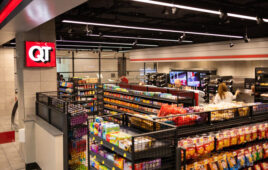Since the first 7-Eleven opened its doors more than 75 years ago, the industry has served as a home for entrepreneurs and family-run businesses focused on meeting the everyday needs of busy consumers. Through the years the industry has lost some of the quaint attributes that made it so appealing to Americans two generations ago when dairy items could be delivered right to their front door and a week’s worth of groceries could be purchased on store credit.
But, in return, the convenience store and petroleum industry-has grown to become the backbone of American commerce. With such important roles as refiners, marketers and employers, the companies that shape this marketplace have done an excellent job of keeping one eye on the “rear-view mirror” without losing sight of what they need to accomplish in the future.
“Over the next 10 years we’ll be a more informed industry,” says consultantDick Meyer, president of Meyer & Associates in New Berlin, Wis. “Marketbasket scan data and performance benchmarking will be tools as commonplace asMicrosoft Office. We’ll know the score on a more timely basis, and I expectthe industry per-store average scores— especially return on investment—willbe a lot more respectable then our past decade.”
The mid-1990s seemed to be an era of prosperity for the convenience marketers as investors lined up to throw money at companies with impeccable—and not so impeccable— financial histories.
Instead, operators by the dozen learned that an infusion of cash to otherwise cash-strapped companies made decisionmakers giddy with financial power. And with power came poor choices, and with the poor choices of a few, the industry’s reputation suffered. Many chains spent frivolously, and rumors swirled throughout the industry about how some chain owners were borrowing money to finance new yachts or vacation homes in South Beach.
Others moved quickly into acquisition mode and bought up individual stores and small chains at two or three times the market value, but made the crucial mistake of not acquiring the land in the majority of these deals—just onerous lease agreements and inventory on back-end heavy loans simply to add their logo atop another building.
Savvy industry veterans, like Allan Davis of White Hen Pantry, recognized an opportunity to sell his 234-store chain to restless mid-sized marketers that wanted to join the ranks of the high-volume players. Davis sold White Hen to Clark Retail Enterprises in 2000 for nearly $100 million, more than double its estimated value. Clark would join the bankruptcy ranks less than two years later.
What marketers failed to realize is that these lenders had little or no concern for whether they were successful. Their job was done once the loan papers were signed. As loan securitization became popular in the mid-1990s, lenders were able to roll-up their loans into bonds that were then marketed to institutional investors. This funneled new money from brokers like EMAC and FMAC into an industry that had traditionally grown up with local banking relationships, says Mark Radosevich, president of PetroConsulting Inc. in Coral Gables, Fla.
The result was a rash of bad investments with virtually no due diligence or long-term planning, “something that never would have happened with the local banker calling the shots,” Radosevich says.
Market changes
By l998, a downturn in the economy, plummeting fuel margins and an 800-poundgorilla called Wal-Mart started chipping away at the industry’s viability. Chainafter chain that was leveraged beyond their means started crumbling, unableto dig out of the mounds of debt they created. Companies that once boasted 200-plusstores, such as Dairy Mart, Swifty Serve, Convenience USA and Fas Mart joinedClark Retail in Chapter 11 bankruptcy, and have become indelibly linked to anera of mismanagement and corporate greed that made firms like Enron and WorldComhousehold names.
Today, poor financial management is becoming the exception and not the rule. Companies like The Pantry Inc., Alimentation Couche-Tard and Valero have done very well with expansion strategies centered on acquiring stores with good-sized lots in high-volume locations. These companies often were able to skim the cream off the top of the high-profile chains languishing in bankruptcy.
Couche-Tard, for example, grabbed Dairy Mart for pennies on the dollar, keeping the profitable units and spinning off the “dogs” to local operators or shutting them down entirely.
“Couche-Tard made probably the best deal with a bankruptcy court that I’ve witnessed in almost 30 years,” Meyer says. “They committed to take over certain stores they knew were good sites. They then proposed to manage other stores for a period of time until they could study their potential. Under their tutelage and management style, you saw a professional team with focus and discipline make selected sites become more profitable.”
The success stories of the past decade don’t end with Couche-Tard and The Pantry. The company to make the biggest splash in the market during that time was Valero.
Success by design was at the heart of Valero’s expansion as it burst onto the national scene in the late 1990s. The San Antonio refiner-marketer went on an acquisition spree of refineries being dumped by small refiners that feared their facilities were too old and too expensive to upgrade as cleanerburning boutique fuels and federal clean air regulations began to take shape.
Valero Chief Executive Bill Greehey pounced on this opportunity, growing asmall regional business with one refinery into a $75 billion powerhouse with18 processing plants throughout the U.S. and Caribbean. Along the way, he acquiredan established retail marketing brand, Ultramar Diamond Shamrock, and the seedsfor its own retail brand were planted.
“Many in the industry were highly critical of Valero’s decision to spin off its profitable natural gas assets to focus on the refining side of its business,” explains Ken Applegate, Valero’s vice president of wholesale marketing. “But we believed that the refining industry was at the bottom of the cycle and that the future would belong to those who could process the least expensive crude oil into premium products.”
While others cowered, Valero recognized that the movement to cleaner fuels would tighten refined product supplies—making refineries more valuable and their products more profitable. The company also set a goal of having two million barrels per day of refining capacity by 2003—a target many insiders thought was unrealistic.
“Before we had even completed the sale of our natural gas facilities, we reached an agreement to buy three refineries for pennies on the dollar. This was the start of a string of highly successful acquisitions in which we were able to acquire distressed refineries at very good values, and upgrade them to improve their profitability,” Applegate says. “This strategy enabled us to reach our processing goal.”
In the span of just eight years, Valero also expanded its portfolio to include a network of 5,000 retail and branded wholesale locations. “The lesson we learned from watching other companies is that you have to be aggressive and have a clear plan,” Applegate says. “We avoided the mistakes others made.”
Food for thought
Avoiding the same problems other chains have made doesn’tguarantee future success. But even as marketers reflect on some of the winningstrategies of the past decade, the industry still has difficulty convincingoutsiders that it’s an innovator in areas like retail technology, foodserviceand labor management.
“Like everyone else, we saw foodservice as a way to maximize the p
otentialof the property by pulling more customers in off the street, and hopefully,adding new revenue streams to the bottom line,” said Win Dozier, president ofTroy, N.C.-based Quick Chek Inc., which operates 26 locations throughout NorthCarolina.
“What many people don’t realize when adding a food program is that customers aren’t going to magically appear,” he says. “It’s not just about the food. It’s about integrating a new pointof-sale system, developing a marketing plan, educating and training employees and showing a level of commitment that you didn’t previously have.”
Dozier dabbled in food programs for years before conceding he needed to developnew profit centers in order to keep the business afloat. The logical answerwas branded foodservice. “Like everyone else, we saw this as a way to maximizethe potential of the property by pulling new customers in off the street,” hesays.
Quick Chek added concepts like Hot Stuff Pizza, Hardee’s and Church’s Chicken. While admitting that it hasn’t been easy, Dozier said, investing in these concepts has created long-term stability for the company.
“We are definitely attracting more customers, but foodservice is a radical departure from the typical c-store mindset, and we’ve struggled with it at times,” Dozier says. “The big question is, ‘How much ancillary business does foodservice bring to the table and is it the best use of our space to keep us on a stable platform?’ That’s still hard to answer.”
Financial outlook
Thanks in part to the stability foodservice has providedmany marketers, the industry is as strong as ever. Whether it’s private companies,public operators or Big Oil, the industry has an enormous impact on the economyas a retailer, employer and long-term investor. Holding onto these strengthswill be challenging as hypermarts and drug stores continue targeting the conveniencetrip.
As long as those threats exist, no one is immune from competition, warns Stu Crum, general manager of retail strategy for Shell Oil Products.
“Hypermarkets and other nontraditional fuel sellers are putting a lot of pressure on site level profitability,” Crum says. “In response, oil majors are now focused on improving cost efficiency and on differentiating products and services.”
For example, many Big Oil brands are turning over entire markets to wholesalers that are better positioned to deliver cost efficiency or points of differentiation to gain an edge in the marketplace. This is a trend the oil majors are predicting is going to continue throughout the next decade.
“In other instances, oil companies are trimming unprofitable sites from their networks to refocus capital investments into larger c-stores and higher fuel volume sites with a superior brand image,” Crum says.
Which solution is right? According to Meyer, there are positive attributes in both strategies. Building a strong brand portfolio comes down to mastering key areas such as people, real estate, equipment and capital.
“Companies that compare their productivity against industry averages and monitor their own historical trends are companies I’d bet on in a heartbeat,” Meyer says.
With healthy companies like Valero and The Pantry, Meyer is convinced the industryhas learned from its mistakes and has a bright future. “I believe the c-storeindustry is on its strongest footing ever, but we have several issues that shouldbe monitored closely,” he says. These include:
• Fuel margins. Meyer is projecting that 2005’s pooled cents per gallonwill be very favorable compared to the past five years. “Instead of puttinga few acorns away, however, it looks like we spent more liberally than perhapswe should have in the controllable expense categories, while continuing to linethe pockets of the monopolistic credit card companies,” he says. “We have toprevail against the obnoxious fees of Master Card and Visa.”
- Organizational prowess and technology benefits. “Implementation”and “execution” are key attributes of chains that are leveraging their increasednumber of sites. Couche-Tard is one example of a smart operator culling downexcessive general and administrative costs to affordable levels, includingreorganizations that have the field personnel spend more time in the storesand flatten the organization. Other regional chains like Krause Gentle aredoing this well too, according to Meyer. “I summarize their hallmark traitsas a high sense of urgency and lots of passion and pride,” he says.
- Cost of capital. The economy has enjoyed a long spell of low interestrates. If not for this lower debt cost, the industry likely would have experiencedmore bankruptcies. The Pantry is one public company that initially was hurtfrom an untimely Initial Public Offering during rising interest rates, Meyersays. However, they managed to sustain themselves, and when interest ratesdeclined they traded in some old debt for new lower cost funding. Those changesdramatically helped their cash flow and they took much of these benefits totheir pre-tax profit line, Meyer says.
- Benchmarking and accountability. Firms like CStoreXchange (CSX) givethe industry its first opportunity to have instant online access to performancemetrics that almost every other retail channel takes for granted. CSX studiedthe data of about 200 c-store and wholesaler companies and concluded thatcompanies that measure their trends against national and regional averagesto seek revenue and cost-containment opportunities, “do, in fact, make higherthan average pre-tax income,” Meyer says.
|
CSX asked industry consultant Dick Meyer, president of Meyer &Associates (New Berlin, Wis.), to identify top metrics that should serveas a barometer for operators looking to gauge their company’s financialperformance. His metrics include: * Facilities and equipment productivity.This includes tracking monthly fuel gallons plus inside sales per storeand average inside sales per store per square foot.
|




